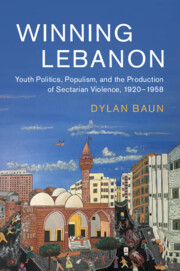Book contents
- Winning Lebanon
- Cambridge Middle East Studies
- Winning Lebanon
- Copyright page
- Dedication
- Epigraph
- Contents
- Figures, Maps, and Tables
- Acknowledgments
- A Note on Conventions
- Introduction
- 1 The Future of Young Men
- 2 Producing Space
- 3 Broadening the Base
- 4 In Defense of Lebanon
- 5 Fighting the Punks
- Epilogue
- Bibliography
- Index
- Books in the Series
5 - Fighting the Punks
The Routine Practices and Sectarian Outcomes of the 1958 War
Published online by Cambridge University Press: 16 October 2020
- Winning Lebanon
- Cambridge Middle East Studies
- Winning Lebanon
- Copyright page
- Dedication
- Epigraph
- Contents
- Figures, Maps, and Tables
- Acknowledgments
- A Note on Conventions
- Introduction
- 1 The Future of Young Men
- 2 Producing Space
- 3 Broadening the Base
- 4 In Defense of Lebanon
- 5 Fighting the Punks
- Epilogue
- Bibliography
- Index
- Books in the Series
Summary
Chapter 5 analyzes the dynamics of the fighting itself, starting in the summer months of 1958. First, it takes up the place of ritual in the 1958 War. By focusing on the Kataʾib’s shift, from the sidelines to frontlines, I argue that routine practices linked to youth belonging, play, and order were mobilized to perform violence. More broadly, whether it was singing a group anthem at an initiation ceremony before battle or marching in a funeral procession for a fallen fighter, popular organizations of all shades mobilized the youth cultures that were cultivated over past decades to win Lebanon. Chapter 5 also discusses several fronts of the war, including the final battle in Beirut between the Kataʾib and Najjadeh. While some scholars contend this phase was one of sectarian bloodletting, the reality was more complex. Neither side used exclusively sectarian discourse to describe other popular organizations. Instead, they deployed coded language, describing their enemies as maddened punks. This reality leads to Winning Lebanon’s main conclusion on sectarianism and sectarian violence. In the course of this conflict, youth, or youthfulness, terms with little connection to sect, became linked to sectarian violence, in practice and discursively, a trend that continued beyond 1958.
- Type
- Chapter
- Information
- Winning LebanonYouth Politics, Populism, and the Production of Sectarian Violence, 1920–1958, pp. 155 - 185Publisher: Cambridge University PressPrint publication year: 2020

